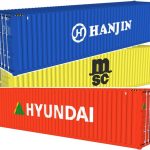The Rise of Port Alliances

international shipping cargo ship port
“Five large terminal companies and one European port authority have joined together to file a discussion agreement with the Federal Maritime Commission (FMC) in attempts to establish a structured organization to advance their efforts to promote the efficiency and effectiveness of the container port industry,” Chris Dupin reported in an article for American Shipper yesterday.
This is the next phase in the increasing cooperation and consolidation happening in the international shipping industry.
The international shipping industry has always been a cooperative industry. Moving cargo around the world requires ports to work with carriers, truckers, rail lines… Freight forwarders connect shippers with carriers, working to get the best routing for cargo at the best freight rates….
However, each part of the supply chain is supposed to have multiple companies competing for shippers’ cargo. Trucking companies compete for moving the cargo across land to and from ports, ports compete with each other for handling imports and exports, carriers compete to sale shipping containers across the ocean, etc.
This competition, according to economic theory, should ensure that companies across the supply chain provide the best customer service and efficiency they can. In the last few years, competition in the international shipping industry has been shrinking right before our eyes.
It starts with the ocean carriers.
For several years, carriers have struggled with slower than expected global growth in international shipping, overcapacity, and low freight rates. To counter huge financial losses, carriers have turned to alliances–working together, sharing ships–to decrease costs and increase efficiency to help their bottom lines.
Alliances dominate the oceans as pretty much all major carriers work in cooperation with “competitors” while mergers, buyouts, and bankruptcy shrink the number of carriers that are competing to ship shippers’ cargo.
It only makes sense that if carriers are working together, ports would start doing the same.
Carrier alliances have put extra strain on ports. Multiple carriers combining their cargo loads on single ships, often megaships, means ports have to deal with much higher quantities of shipping containers at once. This has helped create congestion, but is only one of many challenges ports face.
After contentious labor negotiations between the Pacific Maritime Association (PMA) and the International Longshore & Warehouse Union (ILWU) and a shortage of chassis and truckers combined with bigger ships loaded up by carrier alliances during international shipping’s peak season in 2014 to cause out of control levels of congestion, the Ports of Los Angeles and Long Beach increased cooperation to fight congestion, increase efficiency, and re-earn shippers’ trust.
The structured organization that the terminals and port filed a discussion agreement with the FMC to form is a much bigger thing than partnership between the twin ports of Los Angeles and Long Beach.
If approved, this organization could give rise to a global network of ports working together or the creation of several alliance-like organization between groups of ports. This could be the beginning of a shift in the international shipping industry where ports follow the trend started by carriers.
I do not want to suggest that port alliances are a bad thing or even that they would necessarily cause a decrease in competition. However, the way such organizations operate should be of particular interest to shippers.
American Shipper actually published a copy of the Global Ports Group Agreement that was filed with the FMC.
Here are a few key points to note:
Parties to Agreement
The agreement is between APM Terminals, DP World, Hutchison Port Holdings, PSA International, the Shanghai International Port (Group) Co., and the Port of Rotterdam Authority. The agreement does leave it open for more parties to join the proposed organization.
Geographical Scope
The geographical scope of the agreement includes “all United States ports and points and all foreign ports and points…” So, yeah, we could just say everywhere.
The agreement does say in its “Geographic Scope” section that its members will respect and comply with antitrust and competition laws of all applicable jurisdictions.
Agreement Authority
While the parties of the agreement are meant to meet, share information, discuss issues, and create concerted actions, members are not required exchange information or implement actions the organization comes up with.
If any discussion or exchange of information results in any proposals or agreements of concerted action, those proposals or agreements shall be subject to the right of each Member to independent action and to necessary approvals or requirements of Governments. Nothing herein shall be construed as obligating any Member to provide or exchange information with other Members or the Group. Information and documents exchanged between the parties under authority of this Agreement will be filed with the Commission and will be exempt from disclosure under 60) of the Shipping Act of 1984, as amended.
How large and influential this organization becomes will be interesting to watch. Will other ports and terminals want to join? Will other terminals and ports instead be more interested in forming their own cooperative organizations?
The hope for shippers is that the end result is more efficient and dependable ports. Of course, there will be some worry that this signals one more area in international shipping to see a decrease in competition.




